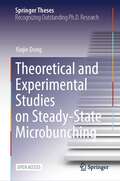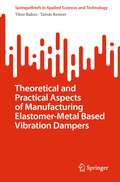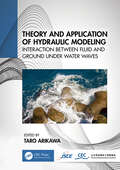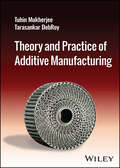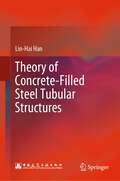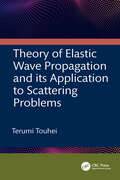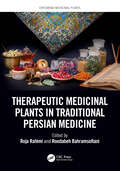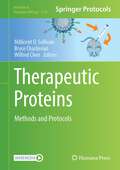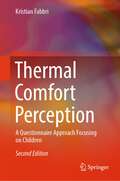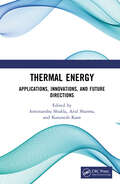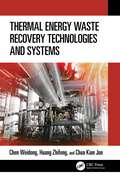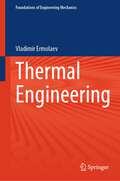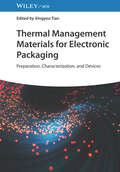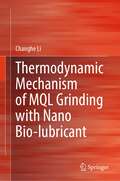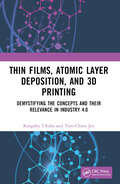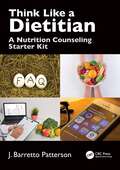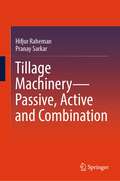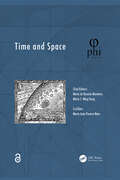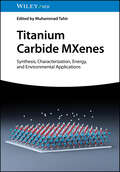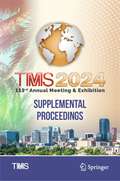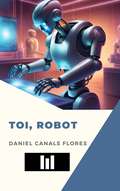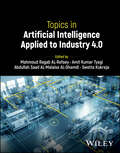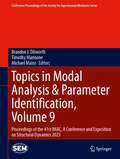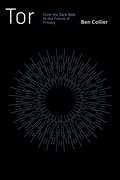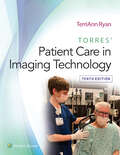- Table View
- List View
Theoretical and Experimental Studies on Steady-State Microbunching (Springer Theses)
by Xiujie DengThis open access book is devoted to the theoretical and experimental studies of a novel accelerator light source mechanism called steady-state microbunching (SSMB) which promises high-power, high-repetition rate, narrow-band coherent radiation in an electron storage ring. The contribution of this dissertation consists of three parts: first, answers the question of how to realize SSMB from a beam dynamics perspective; second, reveals what radiation characteristics can we obtain from the formed SSMB; and third, experimentally demonstrates the working mechanism of SSMB in a real machine for the first time. The highlights of this book can be summarized as: Presents the first proof-of-principle experiment of a promising accelerator light source mechanism; Covers precision longitudinal and transverse-longitudinal coupling dynamics in a storage ring; Provides useful formulas and example parameters for high-power infrared, EUV and soft X-ray light source design.
Theoretical and Practical Aspects of Manufacturing Elastomer-Metal Based Vibration Dampers (SpringerBriefs in Applied Sciences and Technology)
by Tibor Babos Tamás RennerThis book offers a comprehensive breakdown of rubber industry procedures, serving as an invaluable resource for enhancing professional literacy. It covers measurable technological parameters, manufacturing processes, and metallurgy of the materials required for producing high-value rubber-metal machine components. These components find wide applications in the engineering industry, including buffers, vibration damping elements, pipe expansion joints, and silent blocks (vibration dampers vulcanized between steel pipes). The manufacturing of modern machine components necessitates meeting high technical standards and ensuring flawless performance throughout their lifetime. This goal is accomplished by manufacturing components to the required technical parameters with consistent quality specified during the design stage. Unfortunately, scientific descriptions of rubber-metal bonding technologies often lack the detail required for practical application. This book addresses this gap by presenting extensive research conducted by Renner Rubber Products, a key player in the rubber market in Central Europe, drawing on practical experience from the Centre for Security Studies at the Hungarian University of Agriculture and Life Sciences. The book provides a set of technological specifications for rubber-metal bonding based on experiments, measurements, calculations, and proven research results. A noteworthy aspect of the book is that it is the result of close scientific collaboration between academia and industry-leading players, resulting in a highly qualified product applicable in science, academia, and industrial production alike. It serves as a valuable tool for anyone in the engineering industry seeking to enhance their understanding of rubber industry procedures and produce high-quality rubber-metal machine components.
Theory and Application of Hydraulic Modeling: Interaction between Wave and Ground Motion
by Taro ArikawaThis edited volume from Japan’s Research Subcommittee on Methodology for Dealing with Geomaterials in Hydraulic Model Experiments presents readers with a state-of-the-art overview of experimental and computational methods used to address similarity scaling incompatibilities present in fluid–sediment flows.Readers will gain an understanding of complex phenomena in the boundary fields of hydraulics and geotechnical engineering. Chapter contributors focus on the phenomena that are affected by the interactions between fluid wave and ground in a complex field, which for many years have been challenging to process and model. In addition to describing the implementation of model tests and the concept of the law of similarity, this book contrasts these phenomena with the laws of similarity, describes models and numeral analysis methods, and explains important considerations using experimental case studies. Each chapter is written by leading researchers in Japan who are members of the Research Subcommittee on Methodology for Dealing with Geomaterials in Hydraulic Model Experiments. The chapters are closely linked but are written so that each can be read individually. Readers will be able to apply this knowledge to their work and to create models that more accurately simulate the interactions between wave and ground, allowing them to better understand these phenomena and devise more appropriate strategies for defense and so on when necessary.This collection provides information that can be used by young researchers and post-graduate students in the boundary fields of hydraulics and geotechnical engineering who aim at becoming civil engineers, and it will be of particular value to practicing engineers of all experience levels who must regularly analyze complex interactions between fluids and ground.
Theory and Practice of Additive Manufacturing
by Tuhin Mukherjee Tarasankar DebRoyTheory and Practice of Additive Manufacturing Discover the ins and outs of additive manufacturing in this student-friendly textbook Also known as 3D printing, additive manufacturing is a process by which layers of material are added to create three-dimensional objects guided by a digital model. It has revolutionized the design and manufacture of customized products, facilitating the rapid, flexible production of a huge range of goods. It promises to revolutionize manufacturing engineering, shorten industrial supply chains, and more. Theory and Practice of Additive Manufacturing provides the first introduction to this subject designed specifically for students. Balancing the underlying theories behind additive manufacturing with concrete applications, it guides readers through basic processes, essential tools and materials, and more. The result is ideal for readers looking to bring additive manufacturing to bear on engineering or industry careers of almost any kind. Theory and Practice of Additive Manufacturing features: Over 100 worked-out example problems Detailed discussion of the emerging digital tools including mechanistic modeling, machine learning, and more Commitment to pedagogy and reinforcement geared toward student learning outcomes Theory and Practice of Additive Manufacturing is ideal for undergraduate and graduate students and instructors in introductory additive manufacturing courses, as well as practicing engineers and researchers working in industries that use additive manufacturing technologies, including aerospace, automotive, and consumer goods.
Theory of Concrete-Filled Steel Tubular Structures
by Lin-Hai HanThis textbook focuses on concrete-filled steel tubular structures formed by placing concrete inside the steel tube. It deals with the mechanical essence of concrete-filled steel tubular members in compression/tension, bending, torsion, shear and the combined effects, the working mechanism of concrete-filled steel tubular members under long-term load, cyclic load, fire exposure and post-fire exposure, and proposes practical design methods based on experimental and theoretical studies and parametric analysis. The content addresses some key technical issues of concrete-filled steel tubular members, such as the mechanical properties of steel and core concrete, the shrinkage and creep of core concrete, the bonding behavior between steel tube and core concrete, the limiting values for the initial stress of steel tube caused by construction load and the void of core concrete, the protective design of concrete-filled steel tubular members under chloride corrosive environment and impact loading, etc. This textbook also discusses the technology and design principles of concrete-filled steel tubular hybrid structures.
Theory of Elastic Wave Propagation and its Application to Scattering Problems
by Terumi TouheiElastic wave propagation applies to a wide variety of fields, including seismology, non-destructive testing, energy resource exploration, and site characterization. New applications for elastic waves are still being discovered. Theory of Elastic Wave Propagation and its Application to Scattering Problems starts from the standpoint of continuum mechanics, explaining stress and strain tensors in terms of mathematics and physics, and showing the derivation of equations for elastic wave motions, to give readers a stronger foundation. It emphasizes the importance of Green’s function for applications of the elastic wave equation to practical engineering problems and covers elastic wave propagation in a half-space, in addition to the spectral representation of Green’s function. Finally, the MUSIC algorithm is used to address inverse scattering problems. Offers comprehensive coverage of fundamental concepts through to contemporary applications of elastic wave propagation Bridges the gap between theoretical principles and practical engineering solutions The book’s website provides the author’s software for analyzing elastic wave propagations, along with detailed answers to the problems presented, to suit graduate students across engineering and applied mathematics.
Therapeutic Medicinal Plants in Traditional Persian Medicine (Exploring Medicinal Plants)
by Roja Rahimi Roodabeh BahramsoltaniTraditional Persian Medicine (TPM) is one of the oldest medical doctrines, globally known due to pioneering physicians and scientists. The greatest source of natural medicines in TPM originates from medicinal plants. Therapeutic Medicinal Plants in Traditional Persian Medicine provides a background on the history of TPM, as well as an introduction to 40 of the most popular medicinal plants used in TPM. It is a practical guide for readers interested in medicinal plants used in the prevention, management, and treatment of different diseases.Features: Includes both traditional therapeutic applications and modern evidence/ uses Makes a comparison between preclinical and clinical studies Provides information on major chemical constituents, therapeutic uses, adverse reactions, and safety for each plant species A volume in the “Exploring Medicinal Plants” series, this book is a valuable resource for researchers, students, academicians, and scientists dealing witth medicinal plants, as well as for those interested in the fields of pharmacognosy, naturopathy, phytotherapy, and traditional medicines.
Therapeutic Proteins: Methods and Protocols (Methods in Molecular Biology #2720)
by Millicent O. Sullivan Bryce Chackerian Wilfred ChenThis volume covers the latest key aspects of therapeutic protein applications. Chapters in this book cover topics such as the discovery, production, and conjugation of protein-proteins with discussions on the direction of future development and advancements; ways to use these engineering proteins for therapeutic and vaccine applications; and the use of modified protein nanocarriers. Written in the highly successful Methods in Molecular Biology series format, chapters include introductions to their respective topics, lists of the necessary materials and reagents, step-by-step, readily reproducible laboratory protocols, and tips on troubleshooting and avoiding known pitfalls.Cutting-edge and practical, Therapeutic Proteins: Methods and Protocols is a valuable resource for any researcher who are interested in learning more about the field of therapeutic proteins.
Thermal Comfort Perception: A Questionnaire Approach Focusing on Children (Springerbriefs In Applied Sciences And Technology Ser.)
by Kristian FabbriThis book offers a comprehensive exploration of children's understanding and experiences of thermal comfort. The book provides a methodology for evaluating comfort that takes into account the unique perspectives of children. The first part of the book provides an overview of the history of thermal comfort, the human body and environmental parameters, and common thermal comfort indexes. It also offers guidelines for creating questionnaires that accurately assess children's perceptions of indoor thermal comfort. The book then delves into children's understanding of the concepts of comfort and energy, as well as the factors that influence their perception of these concepts. It addresses the psychological and pedagogical aspects of thermal comfort judgment, as well as the architectural and environmental characteristics that contribute to children's perceptions of comfort. First published as Indoor Thermal Comfort Perception, this updated edition also includes new sections on architecture and sensitivity, exploring the impact of classroom spaces on learning, and outdoor education and thermal comfort outdoors, based on qualitative research. These additions provide valuable insights for future studies on these topics. While physical parameter measurements and comfort indexes are useful in thermal comfort, the book emphasizes the importance of ergonomic assessments in the form of questionnaires, which offer unique insights into children's experiences. The book fills a critical gap in understanding children's perceptions of thermal comfort and is essential reading for HVAC engineers, architects, environmental psychologists, and researchers in the medical and cognitive fields.
Thermal Energy: Applications, Innovations, and Future Directions
by Amritanshu Shukla Atul Sharma Karunesh KantThis book presents the essentials of thermal energy storage techniques along with recent innovations and covers in-depth knowledge of thermal energy applications. Different aspects of thermal energy storage systems are covered, ranging from fundamentals to case studies. Major topics covered include application of thermal energy in water heating, solar cooking and solar pond, thermal energy storage materials for indoor comfort in buildings, thermal management of battery, hydrogen production, reducing carbon footprints, and so forth. Key features: Presents current research and technological updates along with applications and market scenarios in thermal energy storage, thermal management, and applications of thermal energy Explores sensible, latent, and thermochemical energy storage aspects Emphasizes the need and adequate utilization of abundant heat energy for clean energy perspectives Reviews use of thermal energy in hydrogen production, the oil and gas sector, along with market analysis Includes pertinent case studies This book is aimed at researchers and graduate students in energy and mechanical engineering, energy storage, and renewables.
Thermal Energy Waste Recovery Technologies and Systems
by Weidong Chen Zhifeng Huang Kian Jon ChuaThermal Energy Waste Recovery Technologies and Systems comprehensively covers thermal energy recovery technologies and systems. It considers thermal sources, working principles, products, application status, prospects, and challenges. In an effort to achieve energy security, carbon neutralization, and sustainable development, this book discusses waste recovery from thermal energy technologies and systems from varying temperatures. This book features case studies of advanced multi-generation systems for different industrial applications. This book is intended for senior undergraduate and graduate mechanical engineering students taking courses in thermal energy, energy systems, and renewable energy, as well as researchers studying thermal energy utilization, low-carbon technologies, thermal dynamic analysis, and energy system design.
Thermal Engineering (Foundations of Engineering Mechanics)
by Vladimir ErmolaevThis book presents the fundamental principles of thermodynamics and heat transfer, providing a solid foundation for understanding energy systems. From the core concepts of basic thermodynamic state parameters and ideal gases to the complexities of real gases and vapors, this book provides the knowledge to analyze and manipulate energy in various engineering applications. It covers topics such as heat capacity, thermodynamic processes, and the First Law of Thermodynamics, giving insights into how energy is harnessed and utilized. The book explores advanced subjects like second law thermodynamics, circular cycles, and the thermodynamic analysis of thermal power cycle installations, unveiling the intricacies of energy efficiency. The second section of the book shifts focus to heat transfer mechanisms, covering thermal conductivity, convective heat transfer, and thermal radiation. The book is useful to anyone interested in the complexities of energy dynamics in engineering systems.
Thermal Management Materials for Electronic Packaging: Preparation, Characterization, and Devices
by Xingyou TianThermal Management Materials for Electronic Packaging Practical resource exploring the theoretical and experimental basis as well as solutions for the development of new thermal management materials for electronic packaging Thermal Management Materials for Electronic Packaging: Preparation, Characterization, and Devices provides in-depth and systematic summaries on cutting-edge thermal management materials for high-power density electronic devices, introducing the preparation methods and application scenarios of thermal management materials for electronic packing, covering refinements of thermal conductivity theory and performance prediction models for multiphase composites, and overall focusing on key scientific issues related to the subject, such as the internal interface of new high thermal conductive substrate materials and the mechanism of spatial topology on performance. The text also discusses key issues on the design and preparation of thermal conductive substrate materials with high thermal conductive properties, including their characterization, properties, and manipulation, as well as the latest methods, techniques, and applications in this rapidly developing area. Sample topics covered in Thermal Management Materials for Electronic Packaging include: Basic concepts and laws of thermal conduction, heat conduction differential equation and finite solution, and thermal conductivity of solids Definition and classification of electronic packaging, thermal management in electronic equipment, and requirements of electronic packaging materials Synthesis and surface modification of high thermal conductive filler and the synthesis of substrates and preparation of thermal conductive composites with inorganic ceramic skeleton structure Assembly of thermal conductive materials in different dimensions and preparation of composite materials, and reliability analysis and environmental performance evaluation Thermal Management Materials for Electronic Packaging serves as an ideal reference for researchers and workers in related fields to significantly improve the mechanical and thermal management properties of materials, expand the material selection and design margin of substrates, and develop substrates that meet the application needs of different gradients.
Thermodynamic Mechanism of MQL Grinding with Nano Bio-lubricant
by Changhe LiThis book discusses the thermodynamic mechanism of MQL grinding with nano-biological lubricant from the force, heat, surface integrity, and micro-morphology.It makes up the fatal defect of the lack of heat transfer capability of traditional MQL grinding. The machining accuracy, surface quality, especially surface integrity of the workpiece, are significantly improved; at the same time, the service life of the grinding wheel is increased and the working environment is improved.The general scope of the book’s content is the effects of MQL grinding with nano-bio-lubricant on grinding force, thermal mechanism, and surface.It provides a new method of sustainable green grinding for environment-friendly, resource-saving, and energy-efficient utilization and solves the technical bottleneck of the insufficient capacity in MQL heat transfer.
Thin Films, Atomic Layer Deposition, and 3D Printing: Demystifying the Concepts and Their Relevance in Industry 4.0
by Kingsley Ukoba Tien-Chien JenThin Films, Atomic Layer Deposition, and 3D Printing explains the concept of thin films, atomic layers deposition, and the Fourth Industrial Revolution (4IR) with an aim to illustrate existing resources and give a broader perspective of the involved processes as well as provide a selection of different types of 3D printing, materials used for 3D printing, emerging trends and applications, and current top-performing 3D printers using different technologies. It covers the concept of the 4IR and its role in current and future human endeavors for both experts/nonexperts. The book includes figures, diagrams, and their applications in real-life situations. Features: Provides comprehensive material on conventional and emerging thin film, atomic layer, and additive technologies. Discusses the concept of Industry 4.0 in thin films technology. Details the preparation and properties of hybrid and scalable (ultra) thin materials for advanced applications. Explores detailed bibliometric analyses on pertinent applications. Interconnects atomic layer deposition and additive manufacturing. This book is aimed at researchers and graduate students in mechanical, materials, and metallurgical engineering.
Think Like a Dietitian: A Nutrition Counseling Starter Kit
by J. Barretto PattersonWhile courses in nutrition counseling teach providers to listen to their patients, this book gives registered dietitian nutritionists (RDNs) a heads-up on what to listen for, with educational materials that address the everyday challenges many people, hence many RDNs, face.Split into four distinct sections, this book equips readers with comprehensive education and counseling for the most common nutrition referrals.Topics include:- How to structure a nutrition counseling session, from getting a patient to open up to empowering them with information and strategies for self‑care.- Strategies for the provider to address personal challenges such as cultivating empathy, implicit bias, and cultural competence.- Routine eating patterns and challenges reported in nutrition counseling, such as night eating, emotional eating, and more.- Common reasons for referral to a dietitian, and frequently asked questions on topics including diabetes, heart disease, kidney disease, irritable bowel syndrome, and weight counseling.- Special issues in health educationThis book is appealing to both early nutrition professionals and experienced dietitians alike, providing a holistic tool kit for RDNs of all levels of experience.
Tillage Machinery—Passive, Active and Combination
by Hifjur Raheman Pranay SarkarThis textbook comprehensively covers the fundamental concepts of tillage operation, including all the three kinds of tillage implements, viz. passive, active and combination. It discusses functional analysis, principle of operation, and testing of main tillage machinery. This textbook includes the design procedure and numerical examples to reinforce the theoretical concepts. It incorporates a lucid style of writing with easy-to-understand design procedure of different tillage implements. This textbook is highly useful for graduate and postgraduate students studying farm machinery and power engineering, design of agricultural machines, and allied fields.
Time and Space (PHI)
by Maria do Rosário Monteiro Mário S. Ming KongThe texts presented in Proportion Harmonies and Identities (PHI) Time and Space were compiled to establish a multidisciplinary platform for presenting, interacting, and disseminating research. It also aims to foster awareness and discussion on Time and Space, focusing on different visions relevant to Architecture, Arts and Humanities, Design and Social Sciences, and its importance and benefits for the sense of identity, both individual and communal. The idea of Time and Space has been a powerful motor for development since the Western Early Modern Age. Its theoretical and practical foundations have become the working tools of scientists, philosophers, and artists, who seek strategies and policies to accelerate the development process in different contexts.
Titanium Carbide MXenes: Synthesis, Characterization, Energy and Environmental Applications
by Muhammad TahirTitanium Carbide MXenes Discover the future of solar energy with this introduction to an essential new family of materials MXenes are a recently-discovered family of two-dimensional organic compounds formed from transition metal carbides. Their unique properties, such as high stability and electron conductivity, have made them a sought-after commodity with many industrial applications in cutting-edge industries. In particular, titanium carbide MXenes look poised to have significant applications in the solar energy industry, with potentially revolutionary consequences for the sustainable energy future. Titanium Carbide MXenes offers a thorough and accessible introduction to this family of compounds and their possible applications. It begins by surveying the fundamentals of the MXene groups, before characterizing titanium carbide MXenes and their processes of synthesis. It then moves on to discuss applications, current and future. The result is a must-read for researchers and professionals looking to synthesize and construct these materials and apply them in sustainable industry. Titanium Carbide MXenes readers will also find: Detailed treatment of MXenes including nitrides composites, perovskites composites, and more Discusses applications in photocatalytic CO2 reduction, hydrogen production, water splitting, and more Roughly 100 figures illustrating key concepts Titanium Carbide MXenes is a must-have for materials scientists, catalytic chemists, and scientists in industry.
TMS 2024 153rd Annual Meeting & Exhibition Supplemental Proceedings (The Minerals, Metals & Materials Series)
by The Minerals, Metals & Materials SocietyThis collection presents papers from the 153rd Annual Meeting & Exhibition of The Minerals, Metals & Materials Society.
Toi, robot
by Daniel Canals FloresToi, robot, Il est un sérieux avertissement pour l’humanité. En écrivant cette histoire, un frisson m'a traversé l'âme: l'acronyme I.A. (Intelligence Artificielle) correspondent à celles du génie robotique incontesté Isaac Asimov. Le professeur en était-il conscient? Ce livre est un hommage à son œuvre et à sa vision futuriste inquiétante. La quatrième révolution industrielle et l'égoïsme de quelques-uns engendreront le monstre qui finira par dominer l'Univers et détruire l'espèce humaine...
Topics in Artificial Intelligence Applied to Industry 4.0
by Mahmoud Ragab AL-Refaey Amit Kumar Tyagi Abdullah Saad AL-Malaise Swetta KukrejaTopics in Artificial Intelligence Applied to Industry 4.0 Forward thinking resource discussing emerging AI and IoT technologies and how they are applied to Industry 4.0 Topics in Artificial Intelligence Applied to Industry 4.0 discusses the design principles, technologies, and applications of emerging AI and IoT solutions on Industry 4.0, explaining how to make improvements in infrastructure through emerging technologies. Providing a clear connection with different technologies such as IoT, Big Data, AR and VR, and Blockchain, this book presents security, privacy, trust, and other issues whilst delving into real-world problems and case studies. The text takes a highly practical approach, with a clear insight on how readers can increase productivity by drastically shortening the time period between the development of a new product and its delivery to customers in the market by 50%. This book also discusses how to save energy across systems to ensure competitiveness in a global market, and become more responsive in how they produce products and services for their consumers, such as by investing in flexible production lines. Written by highly qualified authors, Topics in Artificial Intelligence Applied to Industry 4.0 explores sample topics such as: Quantum machine learning, neural network implementation, and cloud and data analytics for effective analysis of industrial data Computer vision, emerging networking technologies, industrial data spaces, and an industry vision for 2030 in both developing and developed nations Novel or improved nature-inspired optimization algorithms in enhancing Industry 5.0 and the connectivity of any components for smart environment Future professions in agriculture, medicine, education, fitness, R&D, and transport and communication as a result of new technologies Aimed at researchers and students in the interdisciplinary fields of Smart Manufacturing and Smart Applications, Topics in Artificial Intelligence Applied to Industry 4.0 provides the perfect overview of technology from the perspective of modern society and operational environment.
Topics in Modal Analysis & Parameter Identification, Volume 9: Proceedings of the 41st IMAC, A Conference and Exposition on Structural Dynamics 2023 (Conference Proceedings of the Society for Experimental Mechanics Series)
by Brandon J. Dilworth Timothy Marinone Michael MainsTopics in Modal Analysis, Testing & Parameter Identification, Volume 9: Proceedings of the 41st IMAC, A Conference and Exposition on Structural Dynamics, 2023, the ninth volume of ten from the Conference brings together contributions to this important area of research and engineering. The collection presents early findings and case studies on fundamental and applied aspects of Modal Analysis, Modal Testing and Modal Parameter Identification including papers on:Analytical MethodsModal ApplicationsBasics of Modal AnalysisExperimental TechniquesOperational Modal AnalysisModal Parameter IdentificationNovel TechniquesRotating MachineryAdditive Manufacturing ApplicationsBiomedical Applications
Tor: From the Dark Web to the Future of Privacy
by Ben CollierA biography of Tor—a cultural and technological history of power, privacy, and global politics at the internet's core.Tor, one of the most important and misunderstood technologies of the digital age, is best known as the infrastructure underpinning the so-called Dark Web. But the real &“dark web,&” when it comes to Tor, is the hidden history brought to light in this book: where this complex and contested infrastructure came from, why it exists, and how it connects with global power in intricate and intimate ways. In Tor: From the Dark Web to the Future of Privacy, Ben Collier has written, in essence, a biography of Tor—a cultural and technological history of power, privacy, politics, and empire in the deepest reaches of the internet.The story of Tor begins in the 1990s with its creation by the US Navy&’s Naval Research Lab, from a convergence of different cultural worlds. Drawing on in-depth interviews with designers, developers, activists, and users, along with twenty years of mailing lists, design documents, reporting, and legal papers, Collier traces Tor&’s evolution from those early days to its current operation on the frontlines of global digital power—including the strange collaboration between US military scientists and a group of freewheeling hackers called the Cypherpunks. As Collier charts the rise and fall of three different cultures in Tor&’s diverse community—the engineers, the maintainers, and the activists, each with a distinct understanding of and vision for Tor—he reckons with Tor&’s complicated, changing relationship with contemporary US empire. Ultimately, the book reveals how different groups of users have repurposed Tor and built new technologies and worlds of their own around it, with profound implications for the future of the Internet.
Torres' Patient Care in Imaging Technology
by TerriAnn RyanNow fully aligned with the latest ARRT and ASRT standards,Torres’ Patient Care in Imaging Technology, 10th Edition, by TerriAnn Ryan, helps students develop the knowledge and skills they need to become safe, perceptive, and efficient radiologic technologists. This student-focused text offers a strong illustration program and a logical organization that emphasizes the connections between classroom learning and clinical practice. Designed to keep readers informed and up to date, it covers current trends and advances in the field and offers an unparalleled array of online teaching and learning resources.
